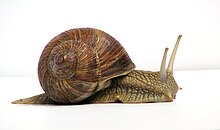Snail: Difference between revisions
m Date maintenance tags and general fixes: build 402: |
James332233 (talk | contribs) |
||
| Line 26: | Line 26: | ||
*[[Heliciculture]] (snail farming) |
*[[Heliciculture]] (snail farming) |
||
*[[Escargot]] |
*[[Escargot]] |
||
and anouther name for will johnston garry! |
|||
==Cultural depictions== |
==Cultural depictions== |
||
Revision as of 12:38, 29 March 2010
This article needs additional citations for verification. (March 2010) |

Snail is a common name for almost all members of the molluscan class Gastropoda that have coiled shells in the adult stage. When the word is used in a general sense, it includes sea snails, land snails and freshwater snails. Otherwise snail-like creatures that lack a shell (or have only a very small one) are called slugs.
Snails can be found in a wide range of environments including ditches, deserts, and the abyssal depths of the sea. Although many people are familiar with terrestrial snails, land snails are in the minority. Marine snails constitute the majority of snail species, and have much greater diversity and a greater biomass. Numerous kinds of snail can also be found in fresh waters. Many snails are herbivorous, though a few land species and many marine species are omnivores or predatory carnivores.
Snails that respire using a lung belong to the group Pulmonata, while those with gills form a paraphyletic group; in other words, snails with gills are divided into a number of taxonomic groups that are not very closely related. Snails with lungs and with gills have diversified widely enough over geological time that a few species with gills can be found on land, numerous species with a lung can be found in freshwater, and a few species with a lung can be found in the sea.
Most snails have thousands of microscopic tooth-like structures located on a ribbon-like tongue called a radula. The radula works like a file, ripping the food into small pieces.
Types of snails by habitat
Slugs
Gastropod species which lack a conspicuous shell are commonly called slugs rather than snails, although, other than having a reduced shell or no shell at all, there are really no appreciable differences between a slug and a snail except in habitat and behavior. A shell-less animal is much more maneuverable and compressible, and thus even quite large land slugs can take advantage of habitats or retreats with very little space, squeezing themselves into places that would be inaccessible to a similar-sized snail, such as under loose bark on trees or under stone slabs, logs or wooden boards lying on the ground.
Taxonomic families of land slugs and sea slugs occur within numerous larger taxonomic groups of shelled species. In other words, the reduction or loss of the shell has evolved many times independently within several very different lineages of gastropods, thus the various families of slugs are very often not closely related to one another.
Snails in cuisine
- Land snail#Snails as human food
- Freshwater snail#As human food
- Heliciculture (snail farming)
- Escargot
and anouther name for will johnston garry!
Cultural depictions

Due to its slowness, the snail has traditionally been seen as a symbol of laziness. In Judeo-Christian culture, it has often been viewed as a manifestation of the deadly sin of sloth.[1] Psalms 58:8 uses snail slime as a metaphorical punishment.
Snails were widely noted and used in divination.[1] The Greek poet Hesiod wrote that snails signified the time to harvest by climbing the stalks, while the Aztec moon god Tecciztecatl bore a snail shell on his back. This symbolised rebirth; the snail's penchant for appearing and disappearing was analogised with the moon.[2] More recently, Carl Jung noted that the snail was representative of the self in dreams. In psychology, the soft insides are analogous to the subconscious, as the shell is the conscious.[1]
One expert, Professor Ronald Chase of McGill University in Montreal, has suggested that the ancient myth of Cupid's arrows might be based on early observations of the love dart behavior of the land snail species Helix aspersa.[3]
In contemporary speech, the expression "a snail's pace" is often used to describe a slow, inefficient process.
The phrase "snail mail" is used to mean regular postal service delivery of paper messages as opposed to the delivery of E-mail or electronic mail, which is virtually instantaneous.
See also
References
- ^ a b c de Vries, Ad (1976). Dictionary of Symbols and Imagery. Amsterdam: North-Holland Publishing Company. p. 430. ISBN 0-7204-8021-3.
- ^ Cooper, JC (1992). Symbolic and Mythological Animals. London: Aquarian Press. p. 213. ISBN 1-85538-118-4.
- ^ "Lovebirds and Love Darts: The Wild World of Mating". news.nationalgeographic.com. National Geographic Society. Retrieved 2010-02-21.
External links
- Predatory snails on the UF / IFAS Featured Creatures Web site.
- Land Snail Ecology
- Snailworlds-Timelaps
